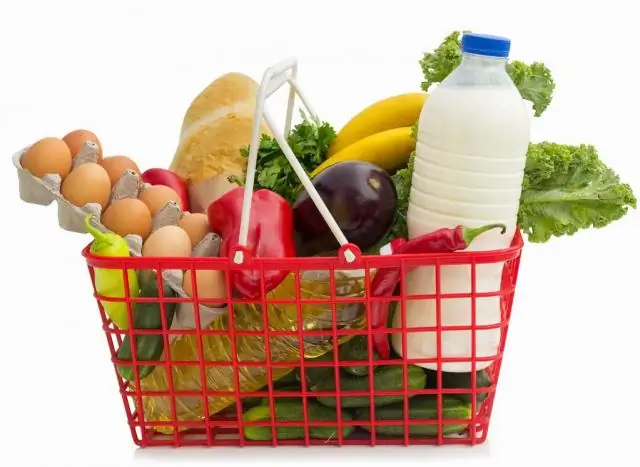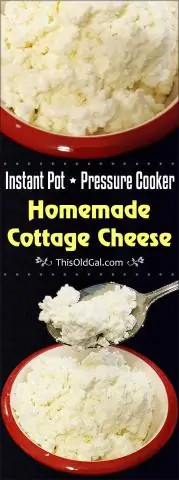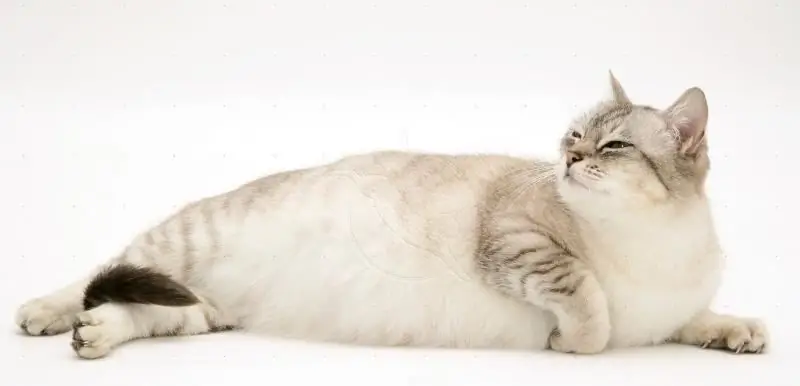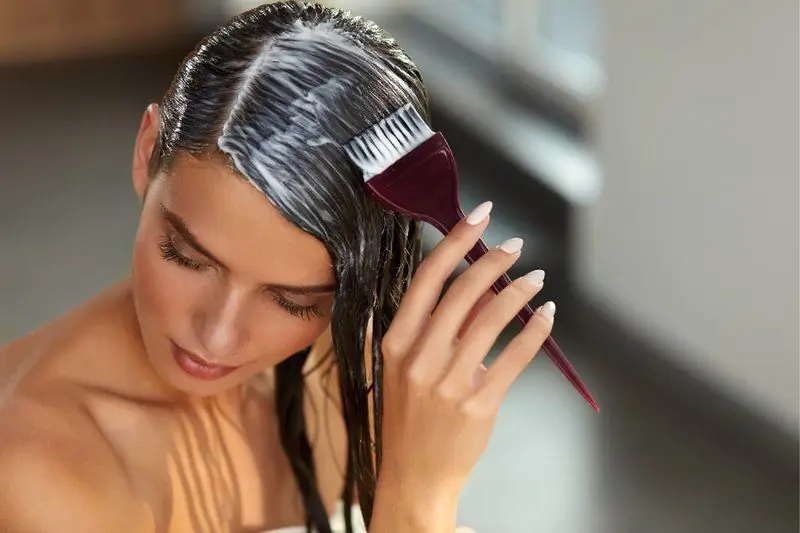
Table of contents:
- Author Bailey Albertson [email protected].
- Public 2023-12-17 12:53.
- Last modified 2025-06-01 07:32.
Nine lives and two sets of teeth

It is said that a cat has nine lives. But she, like most animals, has only two sets of teeth, so changing a kitten's teeth is a very important period in its development, and it is extremely important to create favorable conditions for its course. There are some peculiarities during the period of tooth change, knowing which the owner will be able to take action in time if something goes wrong, or vice versa, avoid unnecessary anxiety.
Content
-
1 The formation of teeth in a kitten
- 1.1 When and how many milk teeth appear
- 1.2 At what age does teeth change
-
2 Teething in a kitten
- 2.1 Sequence and duration of the process
- 2.2 Symptoms
- 2.3 Possible complications when changing teeth
- 3 When a pet needs help
-
4 Tips from a veterinarian dentist
4.1 Video: caring for your cat's teeth
- 5 Tips for caring for your kitten's teeth and gums
The formation of teeth in a kitten
The structure of the teeth of cats is typical of their species, and zoologists consider the structure of the dental system as its morphological sign. The structure of the dental system reflects the nature of its nutrition, and the cat is an undeniable predator - all its dental crowns are conical and are designed to tear the prey to pieces. The teeth located on the jaw form the upper and lower arcades, respectively. For the formation of a breed characteristic - the appearance of a cat's face, the correct formation of dental arches is necessary. Teeth are necessary for capturing, holding and tearing apart prey, the cat uses them to intimidate the enemy, in fights, for grooming, and transferring small objects into the mouth, including kittens.
The laying of tooth buds in cats occurs during embryonic development in the form of a dental plate - this is a fold of the epithelium containing the tooth buds. The inner layer of the cells of the dental plate - enameloblasts, form tooth enamel; the cells of the outer layer are odontoblasts, they form dentin. The connective tissue surrounding the tooth germ forms cementum.
Teething is associated with the development of teeth, when the teeth come out through the mucous membrane of the gums.
Teeth are made up of tissues:
- dentin is the altered bone tissue that makes up most of the tooth. Dentin forms the cavity of the tooth, where the pulp is located, containing blood vessels and nerve fibers;
- enamel is a very durable white fabric that covers the surface of the tooth from the outside, where it comes into contact with the external environment;
- cement - covers the parts of the tooth located in its alveolus - the cell of the jaw where the tooth is located. The cement is represented by a layered bone tissue.
The following parts can be distinguished in the appearance of the tooth:
- tooth crown - a part of the tooth that freely protrudes into the oral cavity and has a chewing surface;
- tooth root - located in the alveolus; the cement of the tooth root and the periosteum of the alveoli connects the periodontium;
- the neck of the tooth - connects the crown of the tooth with its root, here the coating of the tooth changes, the enamel of the crown passes into the cement of the tooth root. The neck of the tooth is normally located in the gum.
By function and form, they are distinguished:
- incisors are small flat teeth, located on the front of the jaws and having one root. The incisor crown has three projections, which wear off over time; the cat uses incisors for gripping and holding, as well as grooming; the roots of the incisors are shallowly immersed in the jaw, therefore, with age, these teeth are often lost;
- fangs - in a cat they have the shape of a dagger, they are sharp and long, their roots are immersed in the bone tissue of the jaws very deeply; used to kill prey; the cat separates the victim's cervical vertebrae with its fangs - this is a characteristic hunting feature of small felines; fangs are used for tearing food; each canine has only one root, the canines are located next to the incisors;
- premolars - small molars; kittens also have them; premolars are needed for chopping food, have a chopping effect; the number of premolars is different on the upper and lower jaws: there are 6 on top, 4. on the bottom. They have 2 or 3 roots, therefore, before removing the premolar, the veterinarian prescribes an X-ray to determine the number of roots and not leave one of them in the jaw; located next to the canines;
- molars - large molars - do not have their milk equivalent, they grow immediately in the form of permanent teeth; molars are also designed to chop and crush food; located along the edges of dental arcades; the upper molars have one root, the lower molars have 2.

During teething, cats try everything on their teeth, it is especially dangerous when they gnaw wires
When and how much milk teeth appear
At birth, the kitten has no teeth at all, but starting from 2 weeks of age, milk teeth begin to appear. The milk set of teeth in a cat is incomplete, since there are no molars - large molars. Milk teeth are called because they appear when the kitten eats milk, and also because of the specific color of the tooth enamel - milky white, translucent. Milk teeth are smaller, sharper and more fragile than permanent teeth. In total, the milk set contains 26 teeth: 12 incisors, 4 canines, 10 premolars.
Terms of teething of milk teeth:
- incisors: the first milk incisor erupts at 2-3 weeks; the second - at 2.5-4 weeks; the third - at 3-4 weeks;
- fangs: milk fangs erupt at 3-4 weeks of life;
- premolars: eruption in 4 to 8 weeks.
It is generally believed that the age of a kitten can be accurately determined by the teeth, but this is not entirely true, since the individual and breed characteristics of the timing of teething can create a large error in the accuracy of this method.
The practical benefit of knowing the average timing of the eruption of milk teeth is expressed in the ability to control their development, since the development of teeth is also an indicator of the development of a kitten.
Teething of milk teeth usually goes unnoticed for the owner of the kitten, because the cat is still too small.

By the age of 2 months, the kitten has a full set of milk teeth
At what age does teeth change
The change of milk teeth to permanent ones occurs at the age of a kitten 3-6 months. The permanent set includes 30 teeth: 12 incisors, 4 canines, 10 premolars, 4 molars.
Teething in a kitten
In most cases, a kitten's teeth change without complications.
Sequence and duration of the process
Terms of eruption of permanent teeth:
- incisors - the first incisor changes at the age of 3-4 months, the second - 3.5-4 months; the third - 4-4.5 months;
- canines - change of canines occurs at the age of 4-5 months;
- premolars - change within 4.5-6 months;
- molars - grow in 4-5 months.

Kitten finishes changing teeth by six months
Symptoms
Changing teeth causes irritation of the gingival mucosa and has both characteristic normal manifestations and deviations from the norm, in the event of which a consultation with a veterinarian is required.
The change of teeth can normally be accompanied by:
- increased production of saliva, slight salivation;
- increased excitability of the kitten;
- decreased appetite;
- a decrease in the speed of chewing food;
- the kitten may try to rub the gums with its paws, as well as bite the surrounding objects;
- especially sensitive kittens can avoid solid foods.

Teeth change in kittens is accompanied by gum irritation
Possible complications when changing teeth
When changing teeth, a number of manifestations are possible that deserve the attention of a veterinarian:
- refusal of food for more than 1 day, usually this is caused by the development of gingivitis or stomatitis, when the inflammatory process spreads from the gums to the mucous membrane of the oral cavity;
- there is a smell from the mouth, this can also indicate the development of gingivitis or stomatitis; the mucous membrane of the oral cavity is reddened, its ulceration is possible;
- eruption of a permanent tooth in the neighborhood of a non-fallen child; At the same time, attention should be paid to the condition of the gums, whether there is inflammation, as well as whether the "delayed" milk tooth does not interfere with the constant growth. If the milk tooth does not disturb the growth of the permanent tooth and there are no inflammatory changes in the mucous membrane, then the milk tooth will fall out on its own without negative consequences.

Milk and permanent teeth can temporarily coexist, the main thing is that there is no inflammation of the gums and obstacles to the growth of a permanent tooth
When your pet needs help
The help of a veterinarian is needed in the following cases:
- inflammation or ulceration of the oral mucosa - gingivitis, stomatitis;
- after the loss of a milk tooth on the jaw, a non-healing wound forms in its place, sometimes with signs of purulent inflammation, which speaks of periodontitis;
- violation of the growth of a permanent tooth in the vicinity of a non-fallen milk tooth, in this case, both a delay in the growth of a permanent tooth and a change in its position in the dentition are possible, while the tooth can begin to injure soft tissues, a malocclusion and even deformation of the bones of the facial skull with the formation of asymmetry of the muzzle. The formed double row of teeth contributes to the accumulation of plaque and the development of inflammatory diseases in the oral cavity, the complication of which can be osteomyelitis of the jaw bones with the formation of fistulas. Shown is the removal of a milk tooth in a veterinary clinic under anesthesia.

Unlike irritation, with gingivitis, redness and swelling of the mucous membrane are more pronounced; pus, pain syndrome, anxiety, depression, food refusal may appear
Veterinarian Dentist Tips
Video: caring for cat teeth
Tips for caring for your kitten's teeth and gums
When changing teeth, it is recommended:
- control the process of changing teeth, examining the kitten's mouth every few days; kittens of breeds prone to the development of gingivitis (Maine Coon, British and Oriental cats, Sphynx) are recommended to be examined daily and contact a veterinarian at the first sign of gingivitis;
- provide the kitten with toys that facilitate the separation of milk teeth and massage irritated gums. Toys should be chosen not too hard, it is better - made directly for cats. Before giving the toy, you must make sure that its staining is stable - moisten a white cloth with water and rub the toy - if there are traces of paint on the cloth, the toy is not suitable. You can buy toys from the humane pharmacy among the products certified for use in children. Before giving the kitten the toy can be held in the freezer, the chilled toy helps to relieve irritation from the gums;
- start gradual training of the kitten to the oral cavity toilet; initially - in order for the kitten to calmly allow to touch the lips, then - to open and examine the mouth, and the goal will be the ability to clean the teeth with a calm behavior of the kitten. Be sure to praise and treat your pet;
- refrain from loosening milk teeth on their own; this is due to the fact that very delicate rudiments of permanent teeth are located near the roots of milk teeth, and accidental damage to the rudiment by a milk tooth that has been displaced as a result of loosening or even a small hematoma formed will lead to the fact that the permanent tooth is deformed or does not grow at all;
- you cannot vaccinate a kitten during a change of teeth - this can both negatively affect the development of teeth, and lead to a vaccination failure; because at this moment all the efforts of the kitten's still imperfect immune system are aimed at localizing the infectious process in the oral cavity, where, naturally, due to the change of teeth, there are huge entrance gates for infection. Vaccinations are either carried out before the change of teeth, or postponed until 6 months of age;
- kitten nutrition is of great importance. It is optimal to use industrial dry food, made specifically for kittens, since they already contain calcium and phosphorus in optimal proportions, which the kitten needs so much. Very good feeds from Canadian producers - Acana, Orijen and others, but from Canada. The Canadian manufacturers are impressed by the fact that despite the global deterioration of the economic situation, they did not skimp on the ingredients of dog and cat food, and their products are still of high quality. If the kitten is on natural food, then you will have to attend to the purchase of vitamin and mineral supplements, for the use of which you need to consult a veterinarian. The kitten needs low-fat cottage cheese as a source of calcium; phosphorus - sea fish. Large pieces of lean meats or poultry work well to facilitate tooth extraction. Raw fish, meat and poultry must be scalded with boiling water, as they can infect the kitten's mouth, which is vulnerable during this period, with bacteria. Also, the kitten really needs vitamins, especially A and D;
- monitor the safety of the kitten during this period, as the kitten tends to gnaw inedible things, especially wires; gnaw and swallow small objects, as well as spoil household and interior items. It is necessary to protect the environment of the kitten as much as possible, since constant supervision over him is impossible;
- if the kitten refuses solid food during the change of teeth, you can offer him canned food or other soft food so that he does not starve and does not lose the pace of development; however, soft foods should not be fed on a consistent basis. If the kitten refuses to eat too often or for a long time, then this is a good reason to visit the veterinarian to exclude gingivitis, stomatitis, periodontitis;
- An unvaccinated kitten during the change of teeth should be in quarantine, both due to the lack of vaccinations and the colostral immunity that has extinguished by this time, and due to the functional overstrain of the immune system that occurs during this period. It is during the period of changing teeth that infection with viral papillomas and other infections characteristic of immunodeficiency conditions often occurs. Infectious diseases during this period arise especially easily, and pose a danger both to the health of the kitten and can affect the formation of permanent teeth.

Modern toys contain plant extracts to flavor breath
While developing, the cat consistently changes the set of milk teeth for permanent ones. This is a serious and crucial stage in her life, since having full teeth is very important for a cat's health. The change of milk teeth occurs between 3 and 6 months of a cat's life, and is characterized by a number of manifestations that can reflect both the normal course of the physiological process and its deviations from the norm. Throughout this period, the kitten needs increased attention of the owner to the state of the oral cavity, where it is necessary to control the compliance with the timing of teething with the average periods, monitor the absence of inflammatory changes in the mucous membrane, as well as the absence of interference with the growth of permanent teeth with persistent milk teeth. When caring for a kitten, it is necessary to take into account the emerging behavioral changes (excitability,the desire to gnaw everything), special nutritional needs (vitamins, trace elements), as well as the concomitant functional insufficiency of the immune system. In case of persistence of milk teeth, delay in the appearance of permanent teeth or a change in their position, suspicion of inflammatory diseases of the oral cavity, you should immediately contact your veterinarian.
Recommended:
How To Make Yogurt At Home - Recipes For Making Drinking, Greek And Other Options From Milk (including Goat Milk), In And Without A Yogurt Maker, Video And Reviews

Properties and types of yoghurts. How to choose products. Homemade recipes in a yogurt maker and without
What To Do If, After Flashing Android, The Phone Or Tablet Does Not Turn On, Does Not See The Network, Does Not Charge

Why does my smartphone or tablet not work after changing the Android version. How to troubleshoot various problems. How to properly reflash a device
How To Make Cottage Cheese From Goat Milk (including Sour Milk): A Recipe With A Photo + Video

Recipes for making cottage cheese from goat milk. Necessary products, step-by-step process description, tips
How Long Does A Cat's Pregnancy Last, What Determines The Period Of Carrying Kittens (including The First Time), Caring For A Pregnant Pet

How long a pregnancy lasts in cats and what it depends on, including if the cat is pregnant for the first time. Stages of pregnancy. Possible problems
Why You Can't Dye Your Hair During Your Period: Signs And Facts

Why you can't dye your hair during your period. What are the consequences of this procedure
